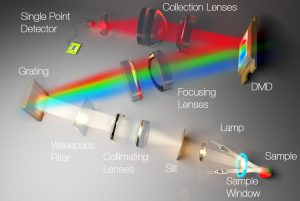

A spectrometer measures wavelength dependent intensity of radiation over a part of the electromagnetic spectrum, and it works by passing a beam through a slit onto a grating and then measuring the intensity of the spatially dispersed radiation that reaches the detector.
There are various types of spectrometers available, and mini spectrometers are popular due to their compact size and lower cost. Mini spectrometers are used for a variety of applications, including colour measurement, semiconductor manufacturing, agriculture and food safety, and process control. They can also cover a broad spectral range, from the ultraviolet to near-infrared.
Gratings are commonly used as the wavelength dispersive element inside mini spectrometers to detect the primary wavelengths. The gratings in mini spectrometers are characterized by two parameters: the blaze angle and the groove frequency. The blaze angle determines the complete shape of the diffraction curve, and the groove frequency determines the amount of dispersion.
Using the correct grating is crucial for spectrometer optimization and to obtain the best spectral results. Important specifications to consider are the size of the grating, the lattice frequency, the effective diffraction wavelength band, and the diffraction efficiency.
One issue with gratings is that wavelengths at higher orders are generated in addition to the primary wavelengths, which need to be removed before reaching the detector. This is a simple task for spectrometers that cover less than one octave, using a long wave pass filter with a fixed cut-on wavelength that should be slightly smaller than the lower wavelength of the spectrometer.
For mini spectrometers that cover more than one octave, for example, 190 nm to 1100 nm, two or three long wave pass filters are required. There will always be a transition region when more than one filter is used, regardless of whether they are directly coated onto one substrate or mechanically assembled. The transition region will collect meaningless signals that can have a negative impact on the results obtained from the mini spectrometer.